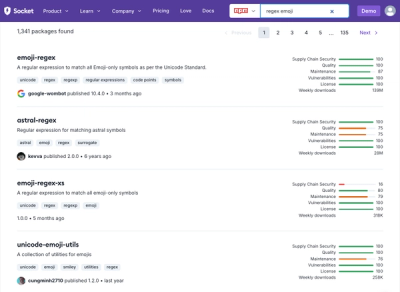
Research
Security News
Malicious npm Package Targets Solana Developers and Hijacks Funds
A malicious npm package targets Solana developers, rerouting funds in 2% of transactions to a hardcoded address.
awsdomainchecker
Advanced tools
Query Domain Name availability with node.js via Amazon Web Services SDK for various tld sites. Compatible with any Node.js app, just integrate this into your application. Make requests for domain availiability on the fly

Query Domain Name availability with node.js via Amazon Web Services SDK.
Compatible with any Node.js app, just integrate this into your application. This is great for use with dns management, domain reservation services, or more advanced logic.
See here for instaling pip - https://pip.pypa.io/en/stable/installing/
See here for configuring IAM policy for route53 - http://docs.aws.amazon.com/Route53/latest/DeveloperGuide/access-control-managing-permissions.html
pip install awscli
aws configure
npm install awsdomainchecker
const awsdomainchecker = require('awsdomainchecker');
Running it is easy, anytime your main app starts awsdomainchecker will auto-start You should get the returned output:
awsdomainchecker listening on http://localhost:8135
Locate the node_modules folder where you have my module 'awsdomainchecker', edit the index.js and change listening port
port = 8135;
app.listen(port);
app.use(bodyparser.urlencoded({extended: true}));
app.use(bodyparser.json());
app.get('/', function(req, res){
console.log('GET /')
const html = fs.readFileSync('index.html');
res.writeHead(200, {'Content-Type': 'text/html'});
res.end(html);
});
app.post('/', function(req, res){
console.log('POST /');
console.dir(req.body);
const route53domains = new AWS.Route53Domains();
res.writeHead(200, {'Content-Type': 'text/html'});
During testing, simply use curl to generate post request only specifying the domain name with top level domain. "domainname.tld".
You can add sanitization around this from your application UI side once running. Contributors to this project should also be looking
forward to oauth integration coming soon, in the mean-time security is on you to sanitize for the time being.
curl -d "DomainName=domain.com" localhost:8135
You should get the returned output:
This Domain is: status <UNAVAILABLE> | <AVAILABLE>
More to come soon....
Invented By: Sulayman Touray {C.E.O SudirlayCoders}
FAQs
Query Domain Name availability with node.js via Amazon Web Services SDK for various tld sites. Compatible with any Node.js app, just integrate this into your application. Make requests for domain availiability on the fly
The npm package awsdomainchecker receives a total of 3 weekly downloads. As such, awsdomainchecker popularity was classified as not popular.
We found that awsdomainchecker demonstrated a not healthy version release cadence and project activity because the last version was released a year ago. It has 1 open source maintainer collaborating on the project.
Did you know?

Socket for GitHub automatically highlights issues in each pull request and monitors the health of all your open source dependencies. Discover the contents of your packages and block harmful activity before you install or update your dependencies.

Research
Security News
A malicious npm package targets Solana developers, rerouting funds in 2% of transactions to a hardcoded address.

Security News
Research
Socket researchers have discovered malicious npm packages targeting crypto developers, stealing credentials and wallet data using spyware delivered through typosquats of popular cryptographic libraries.

Security News
Socket's package search now displays weekly downloads for npm packages, helping developers quickly assess popularity and make more informed decisions.